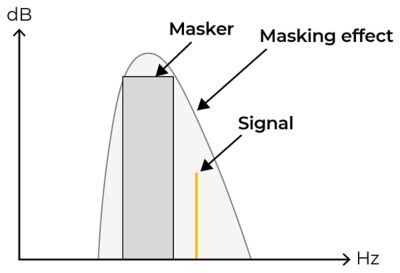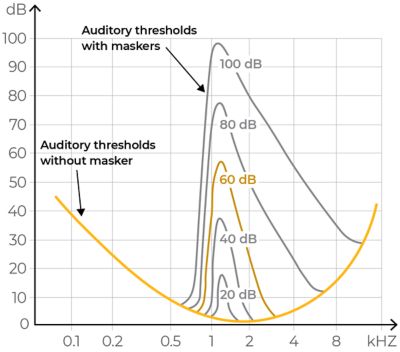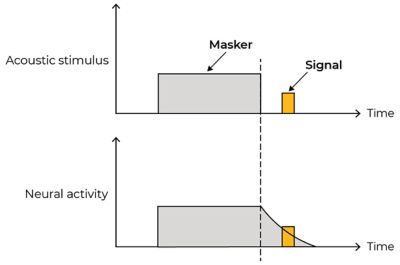-
-
Access Free Student Software
Ansys empowers the next generation of engineers
Students get free access to world-class simulation software.
-
Connect with Ansys Now!
Design your future
Connect with Ansys to explore how simulation can power your next breakthrough.
Countries & Regions
Free Trials
Products & Services
Learn
About
Back
Products & Services
Back
Learn
Ansys empowers the next generation of engineers
Students get free access to world-class simulation software.
Back
About
Design your future
Connect with Ansys to explore how simulation can power your next breakthrough.
Free Trials
ANSYS BLOG
August 22, 2023
Auditory Masking: Using Sound to Control Sound
All around us, myriad noises are competing for perception. But fortunately, all the sounds we can hear aren’t the sounds we do hear. Much of the mechanical, environmental, and social noises that are common in our modern world are hidden by other noises in a phenomenon known as auditory masking. This intersection of sounds — in which one sound blocks another — can either happen naturally (like thunder over a steady rain) or by design (like ambient noise at a dentist’s office).
What is Auditory Masking?
Auditory masking is the reduction of perception of one sound by the presence of another sound. For example, in medical or legal offices, where a high level of privacy is required, sound masking can create a blanket of white noise to prevent unintended listeners from hearing confidential conversations. In electric vehicles, the addition of active sounds can cover the high-frequency tones of the electric motor or the loud booming noise from the chassis. Sound masking helps engineers ensure that undesired sounds (signals) are perceived less by hiding them under other sounds (maskers).
EV interior noise where the original electric motor noise can be heard
EV interior noise with added ICE sound to cover the electric motor noise
Auditory masking is particularly beneficial in scenarios in which reducing a noise is difficult or undesirable. Changing a design to remove the sound can add weight or affect the way a system works, making it slower or less efficient. By masking sounds instead of removing them, engineers don’t have to compromise on designs that are functionally ideal but also noisy.
Types of Masking
There are two types of auditory masking that affect the perception of sounds: simultaneous masking and temporal masking.
Simultaneous Masking
Simultaneous masking (also known as spectral masking or frequency masking) occurs between different frequencies when the signal occurs at the same time as the masker.

Figure 1. Simultaneous masking
For physiological reasons, the perception of some frequencies may block the perception of other frequencies. Let’s take a simple example: When a pure tone at 400 Hz is mixed with a 200- to 600-Hz pink noise, the pure tone cannot be perceived anymore.
Pure 400 Hz tone
200-600 Hz pink noise
Tone and noise
Pure tone: a sound that consists of one single frequency
Pink noise: a sound containing frequencies with equal energy per octave bands
Simultaneous masking is related to the dynamic behavior of the basilar membrane in the cochlea. It occurs when the membrane oscillation created by a sound, which would be normally detected in quiet environment, gets "covered" by the oscillation created by another sound, provided it is loud enough and its frequency is close enough to the first sound.

Figure 2. A signal can be masked by a masker even if their frequency contents do not overlap.
Figure 3 shows the auditory thresholds of pure tones when there is no masker (green curve) relative to the thresholds at which a 1100-1300 Hz broadband noise is added at various levels — 20, 40, 60 and 100 dB SPL (blue and red curves).
For instance, a pure 1000-Hz tone that is perceived at a level of 3 dB SPL without masking noise will only be perceived if it has an intensity of 43 dB SPL with the presence of the 60-dB SPL broadband masking noise. The louder the masker, the bigger the masking effect and the greater frequency range covered. Low frequencies also tend to mask higher frequencies more easily than the inverse.

Figure 3. Auditory thresholds of pure tones when there is no masker (yellow curve) and with maskers (grey and gold curves)
Temporal Masking
Temporal masking, also known as a temporal resolution, occurs between successive sounds. Here, a masker sound either precedes the signal sound (forward masking) or follows it (backward masking).
Forward masking is when the masker is heard before the signal. It can occur for time gap values up to 200 ms between the two sounds. Forward masking is due to the persistence of neural activity, which may impair the detection of the signal.

Figure 4. Forward masking
Backward masking is when the masker is heard after the signal. It only occurs if the time gap value is smaller than 20 ms. Therefore, backward masking is less efficient than forward masking. Backward masking may be caused by listeners misinterpreting the signal with the start of the masker.

Figure 5. Backward masking
Temporal masking affects our sound perception because when a sound occurs, our auditory systems may already be processing other sounds. This causes the perception of overlap between sounds, even though they didn’t actually happen simultaneously.

Figure 6. Neural activity representation of acoustic stimulus
Both simultaneous masking and temporal masking are considered when calculating sound perception metrics. Simultaneous masking is taken into account in most tonality indicators and loudness models for stationary signals, while temporal masking is considered in loudness models for non-stationary sounds and impulse sounds, as well as in the calculation of fluctuation strength.
Auditory Masking Applications
Auditory masking is essential in any field in which sound perception can be negatively influenced by the presence of distracting or unpleasant noises. Understanding and quantifying this phenomenon is beneficial to increasing communication, productivity, and safety.
- Privacy: In spaces where confidentiality and discretion are required, auditory masking can reduce speech intelligibility so private conversations cannot be overheard by unintended listeners.
- Speech enhancement: For communication systems, such as hearing aids, masking can improve speech comprehension by selectively amplifying or suppressing frequency components.
- Audio compression: To save storage space, MP3 and ATRAC (adaptive transform acoustic coding) omit masked sounds to compress file size with an imperceivable change in sound quality.
Engineering software like Ansys Sound enables engineers across industries and applications to listen to, analyze, and design sound sources while taking into account the perceived masking effect.
Turn It Up
While it seems counterintuitive, it’s true: To eliminate an undesirable noise, the best solution may be to add more noise. By strategically layering sounds on top of other sounds at the right frequency and at the right time, auditory masking can totally change how we perceive sounds, making some disappear and others become sharper and more balanced.
To learn more about the psychology and physiology of hearing, read “Psychoacoustics: Understanding the Listening Experience.”